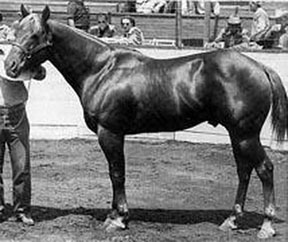|
We all know that muscle
weighs more, based on volume, than fat. A high degree of muscling is one
of the breed characteristics of the Quarter Horse.
A few years back we asked Foundation Quarter Horse members to include the height and weight
of their foundation Quarter Horses on their registration applications.
And, we noticed what seemed to be a curious trend
-- horses that, in the majority, fall well within breed standards as far
as height, but not when it comes to their weight. Since our breed
standards are based on actual advertised weights of well known Foundation
Quarter Horse sires this left us to wonder . . . has the amount of
muscling in the 90-100% foundation bred horse deteriorated so drastically
over the last 40 years from that possessed by their close ancestors? Or
perhaps the weights of horses were mis-reported in advertising by every
major breeder in the country? Or could it be that those currently
registering horses with FQHA are estimating the weights of their horses
based on the current methods available? We believe it may be due to the
latter.
Besides muscling, there is another
aspect of true Quarter Horse conformation that will affect the readings of
a weight tape. A Quarter Horse will typically exhibit a shallower heart
girth and a bigger barrel. This type of lung capacity is different from
the conformation of the typical thoroughbred. Look at enough of the
pictures of the foundation horses of this breed and you will see what I am
talking about.
The following is a brief story to
illustrate the point of the inaccuracy of weigh tapes. I had a little dun
mare a few years ago that was heavy with Jimmy Mac Bee and old Heart Ranch
breeding. She wasnít a bit over 14-2. But she was typical of her breed
with plenty of good Quarter Horse muscling. Not one of those freaks like
you see in most of the AQHA Halter classes these days, just good working
muscle. This was a 100% foundation mare.
Having worked with her quite a bit and
also having listened to the shoer complain about how heavy she was when
she leaned on him occasionally, I was always surprised to see that when
measured by the "tape method" she barely broke 1000 pounds.
Well, one day after a trip to the vet
for a pre-breeding examine, I drove by some truck scales with her in the
trailer and thought, "why not?" I drove on to the scales, had
the truck, and horse trailer weighed with her in it, and then headed home
to unload old Betty.
I was careful to leave all the manure in
the trailer, remove nothing from the truck or trailer but the mare
herself, and then I headed back for a another weigh in. The scale was only
about 4 miles from the ranch so I wasnít to worried about the fuel I was
burning affecting the final weight. The difference between weigh-ins told
me that my dun mare weighed a whopping 1280 pounds (in good flesh). Quite
a difference from the tapeís weight table. She was a Quarter Horse, she
was built like a Quarter Horse and she was dense.
To this day I no longer trust a weight tape when I am
using it on a foundation Quarter Horse. So, if at all possible, weigh your
Foundation Quarter Horses.

Bill Cody, bred by the King
Ranch, was the 1952 AQHA Honor Roll Halter Horse. He exhibits excellent
foundation Quarter Horse conformation, and he is also typical of the true
Quarter Horse body type that will not reflect an accurate weight when
using a weight tape.
|
